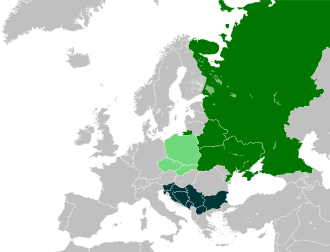East Slavic languages

The East Slavic languages are, along with the South and West Slavic languages, one of the three branches of the Slavic languages , which in turn belong to the Indo-European language family . East Slavic languages are spoken as mother tongue by around 224 million people. Russian in particular gained importance as a world language .
Members of the East Slavic language group
The East Slavic language group includes:
- Russian
- Ukrainian
- Belarusian
- Carpathian and Yugoslav Russian (the latter is alternatively viewed as West Slavic)
- West Polish
as well as historical language forms:
Features of the East Slavic languages
The characteristics of the East Slavic languages compared to the West and South Slavic are:
-
Urslavisch * or, * ol, * er, * el between consonants are represented as oro, olo, ere, olo (so-called full sound );
see. Russian moroz <original Slavic * morzъ 'frost' or moloko < * melko 'milk'. - Original Slavic * tj and * dj are represented as č and ž ;
see. Russian sveča < Original Slavic * světja 'light, candle' or meža < * medja 'Rain'.
history
It is difficult to determine when the East Slavic languages separated from the Ur Slavonic (between the 6th and 11th centuries).
The history of the East Slavic languages is a politically very sensitive topic, as it is viewed by the East Slavs themselves from different perspectives, since they try to find the respective national history in their common history ("sicut ceteri mortalium, originem suam quam vetustissimam ostendere cupientes" - "Like all people, wanting to extend their origins as far as possible into the past", as Aeneas Sylvius noted in his Historia Bohemica in 1458 ).
It is therefore particularly important to have a clear distinction between the history of the East Slavic dialects and the history of the used by the Eastern Slavs written languages to make. Because although most of the old texts reveal the dialect of their authors and / or scribes and thus allow a very precise geographical classification, it should be noted that their authors tried to write in a different written language from their dialects and that the 'mistakes', which today enable localization to be avoided.
In both cases it should always be remembered that the history of the East Slavic languages (before the invention of the record) is only a history of written texts . How the writers of the traditional texts would have spoken in everyday life or how a farmer who did not know how to write spoke to his family can only be extrapolated.
History of the written languages
| History of the East Slavic written languages | |||||||||||||
|---|---|---|---|---|---|---|---|---|---|---|---|---|---|
| History of Ukrainian | History of Belarusian | History of Russian | |||||||||||
|
Vorschriftliche period (up to about 9./11. C.) |
East Slavic dialects of Primal Slavic | ||||||||||||
|
Old era (approx. 9/11 to 14th century) |
Old East Slavic | ||||||||||||
|
Middle epoch (approx. 15th to 18th century) |
Ruthenian | Old Russian (i. E. S.) | |||||||||||
|
New era (approx. Since the 18th / 19th century) |
(Modern) Ukrainian |
(Modern) Belarusian |
(Modern) Russian |
||||||||||
The following is a brief overview of the old and middle epochs. For more information see the Old East Slavic language , Ruthenian language and Russian language .
After the Christianization of the Eastern Slavs, they used books of worship from Bulgaria in "Old Bulgarian", i.e. H. were written in Old Church Slavonic . This language continued to be used in extra-liturgical texts, but was influenced by the East Slavic dialects, so that the so-called Russian Church Slavonic developed from it.
Throughout the Middle Ages (and in some respects until today) there was a certain duality between Church Slavonic as a 'higher' level of style used (mainly, but not only) in religious texts, and a vernacular language more closely approximated to Eastern Slavonic dialects, which was used in secular texts. This situation has been described variously as diglossia (although mixed texts also occur and although it is sometimes hardly possible to determine why a respective author used a vernacular or a Church Slavonic form in a respective context).
History of dialects
| History of the East Slavic dialect groupings | |||||||||||
|---|---|---|---|---|---|---|---|---|---|---|---|
| History of Ukrainian | History of Belarusian | History of Russian | |||||||||
| Mandatory | East Slavic dialects of Primal Slavic |
Now- go- rod? |
|||||||||
| in the 11th century |
Galicia - Podolia - dialects |
Kiev - Polessia - dialects |
Polotsk - Ryazan - dialects |
Novgorod - Suzdal - dialects |
|||||||
| today | SW- | SO- | N- | SW- | Central- | NO- | S- | Medium- | N- | ||
| - Ukrainian dialects | - Belarusian dialects | - Russian dialects | |||||||||
| The above dialect classification and periodization follows Yury Šerech [= Shevelov], Problems in the formation of Belorussian , New York 1953 (= Word: Journal of the Linguistic Circle of New York , Vol. 9, supplement, monograph no. 2), p. 93. | |||||||||||
The first regional differences between the Old East Slavic texts can be seen as early as the 12th century, still in the time of the Kievan Rus . H. Due to their linguistic characteristics, some texts can be assigned to regions that are today in Russia , Ukraine or Belarus . Therefore, some East Slavic linguists claim the existence of separate languages from this early period.
